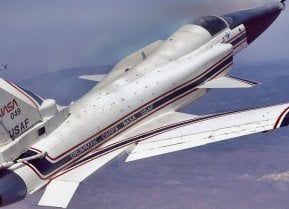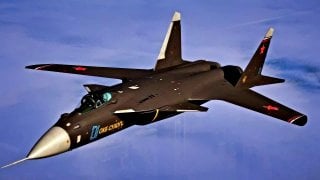Sukhoi Su-47 'Golden Eagle': Russia's First Stealth Fighter Failure
The Su-47 was supposed to be able to evade radar. Is the Su-47 stealthy? Air combat experts don’t agree. It probably had some stealth coatings for radar evasion characteristics, but it was certainly not completely stealthy.
Airplanes fail to make it to production for a number of reasons. Sometimes it is because of design flaws. Other times it is a lack of funding. It may be insufficient research and development. Or the main idea for the airplane is just wrong. For Russia and its Su-47 Golden Eagle it was all of the above.
Su-47: A Short History
The Su-47 program went badly, but it was not for a lack of trying by the Russians.
Moscow had big plans for the Sukhoi Su-47 throughout the 1980s (when it was first known as the Su-37). It was supposed to become a 5th-generation fighter to challenge the American F-22. The plan was to make it stealthy and highly maneuverable in a dog fight.
Also, the Russians thought that it could take off and land with shorter runways, which would prove valuable when deployed on an aircraft carrier.
Forward-Swept Wings Were a Gamble that Russian Designers Lost
The first glaring aspect of the Su-47 is its forward-swept inverted wings. This was something new that proved to be a problem. It also had moveable canards, a second set of small wings next to the cockpit to improve maneuverability and lift.
Therefore, the forward-swept wings, canards, and horizontal tail-stabilizers gave it a unique design with high angles of attack and longer range.
But the Wings Were Not Without Problems
Forward-swept wings have their downsides. They can be unstable. The wings are exposed to heavy stress, particularly at fast speeds. During this kind of pressure, the wings should bend without breaking, a characteristic that proved difficult if not dangerous. Forward swept wings can also lead to unrecoverable stalls.
Forward-swept wings also require extremely sturdy materials to endure the twisting pressure applied on the wing roots. The added weight of the reinforcements turned out to be a problem too difficult for the airplane’s developers to solve.
More Serious Issues With the Wings
Nevertheless, the Russians built a technology demonstrator that first flew in 1997. Problems quickly became apparent.
The lighter composite-fiber wings were at risk when conducting high-speed movements. This resulted in stress cracks that required the replacement of the composite fiber. It would have been nice if this could have been fixed with spot repairs, but this was not the case. It made the Su-47 expensive to maintain. The fighter was already 18-tons without munitions and the added pressure on its wings was going to be a major issue.
However, the Su-47 has a fly-by-wire feature. Computers monitor sensors around the airplane to make automatic modifications that improve in-flight characteristics. This aspect was planned to overcome the problems with the swept wings and provide more stability.
The engines are above average. The two D-30F-11 turbojet engines enabled a speed of MACH 1.65, not MACH 2, which was the Russians’ goal.
Su-47: Not Really Stealthy
The Su-47 was supposed to be able to evade radar. Is the Su-47 really stealthy?
Air combat experts don’t agree. It probably had some stealth coatings for radar evasion characteristics, but it was certainly not completely stealthy. It did have an internal weapons bay which is required for stealth flying.
Could a Russian-DARPA Have Saved the Su-47?
Unlike the Americans, at the time of the Su-47 development, the Russians had no agency comparable to DARPA. Although in 2012, they created the DARPA-like Russian Foundation for Research Projects. This agency could have put the brakes on certain aspects of the airplane’s technology that weren’t going to work. That way, the Su-47 program could have been truly experimental like the U.S. DARPA-developed X-29 that also had forward-swept wings. After testing, DARPA considered the X-29 airplane unstable. Having DARPA as a partner is a good way to not go over budget or experience delays because the agency can quickly cancel a program during signs of trouble. Then certain aspects of the airplane that do happen to work can be used on other fighter planes to help next-generation models.
How About a Competition Between Defense Contractors?
Also, the Russians could have held a competition for something called the “Project 47 Golden Eagle” (Sukhoi versus MiG) that may have resulted in them finding that the forward-swept wings were not going to work much earlier in the prototype’s life cycle – before they ran out of money and resources, for example.
But now Sukhoi and MiG are merging together to create the “Russian Division of Battle Aviation” of the United Aircraft Corporation. So, the idea for two companies to compete on an airplane contract bid (similar to American acquisition practices) may never happen in Russia.
Su-47 Fades Into History
The Su-47 is thus a cautionary tale for airplanes that do not make it to fruition. Only one technology demonstrator was built. The airplane was too experimental and ahead of its time and it died a slow death. No agency such as DARPA was there to give the program a course correction or a timely cancellation. A competition between Sukhoi and MiG could have perhaps given the Russians a better product and ability to determine that the forward-swept wings were a non-starter.
About the Author
Brent M. Eastwood, PhD, is the author of Humans, Machines, and Data: Future Trends in Warfare. He is an Emerging Threats expert and former U.S. Army Infantry officer. You can follow him on Twitter @BMEastwood.


